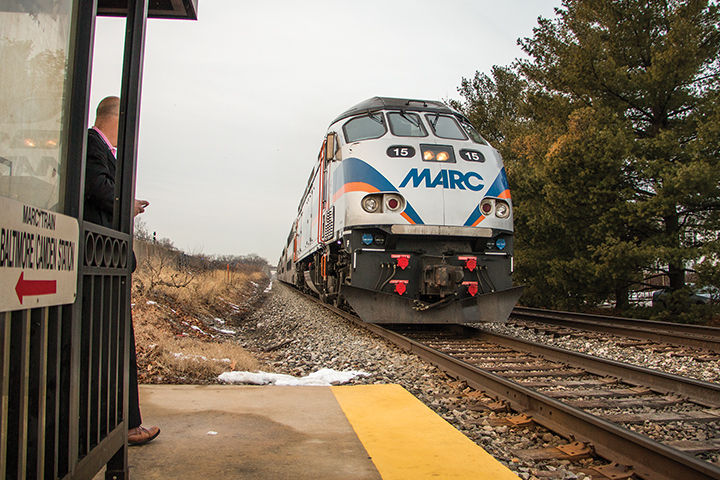
The new double-decker MARC Train approaches the MARC-College Park station on Monday, March 9.
Every day, Joyce Teixeira da Silva waits in College Park — usually for about 20 minutes — before the MARC Train can take her to the University of Maryland, Baltimore, she said.
She commutes twice a day between her home in College Park and UMB’s dentistry school, where she is completing her doctorate, and said she always faces this delay between the bus and the train.
“The timing of the bus is not so close to the timing of [the] leaving MARC Train,” Teixeira da Silva said.
But the Maryland Transit Administration’s addition of a new commuter rail link between Baltimore and Washington drastically shortened her usual wait by several minutes Monday, she said.
City, county and MTA officials met early yesterday morning at the College Park MARC Train station to inaugurate a new route on the Camden Line, which will now also run from Washington’s Union Station to Baltimore’s Camden Station. The maiden voyage on a new bi-level MARC Train ended at a short press conference in Camden Station, where the Camden Line has run since 1835 under CSX infrastructure.
With the new service, students finishing their doctorates and capstones at UMB and students looking to explore Baltimore will be able to reach the city and other transit options in about an hour.
“This is an opportunity we have been working on for years to improve the connectivity between the two campuses,” said Robert Smith, MTA administrator, referring to this university and UMB. “What we’re about is improving access to jobs, access to education, and that’s what it’s all about.”
Although this university’s MARC station is about a mile from campus, the Camden Station is just a 10-minute walk to UMB, Smith said.
Through the efforts of local legislators and MPower, an alliance between UMB and this university, the connected corridor will allow convenient transportation between the two campuses, said Carlo Colella, university vice president.
“A few years ago, [this university] formed a strategic partnership with the University of Maryland, Baltimore, called MPower, and in that short period of time, we have gotten $80 million in research grants,” Colella said.
Colella and other university officials hope the connection will inspire further collaboration between university researchers and UMB faculty in the coming years and ease the congestion of the Interstate 95 corridor, Colella said.
The push for a new MARC line and additional service began two years ago when state Sen. Jim Rosapepe (D-Laurel) and local legislators made it a high priority for the region’s transportation budget and in the city-university partnership, Rosapepe said.
“It came about because the 21st District delegation … made it a high priority when the legislation was considering the transportation financing package in 2013,” Rosapepe said. “So when we were considering the governor’s transportation legislation, we said, ‘To get our votes, you got to add service on the MARC line.’ So that’s when we got the commitment to add this service.”
Trains will begin on the Camden Line at 6:32 a.m. every weekday morning at Union Station, stop in College Park at about 6:44 a.m. and end at Camden Station at about 7:43 a.m., according to the Camden Line schedule.
Additional trains will run every day, including a 5:53 p.m. train leaving from Union Station and arriving in College Park at 6:04 p.m., which will close a 90-minute MARC-service gap at College Park’s station.
MARC will also be adding 54 new cars and five double-decker cars in the coming weeks, Rosapepe said.
“Between the Metro line, the MARC line and the Purple line,” Rosapepe said, “College Park will be the transit hub of suburban Maryland.”
CLARIFICATION: City, county and MTA officials met at the College Park MARC Train station to inaugurate a new route on the Camden Line, which will now also run from Washington’s Union Station to Baltimore.



